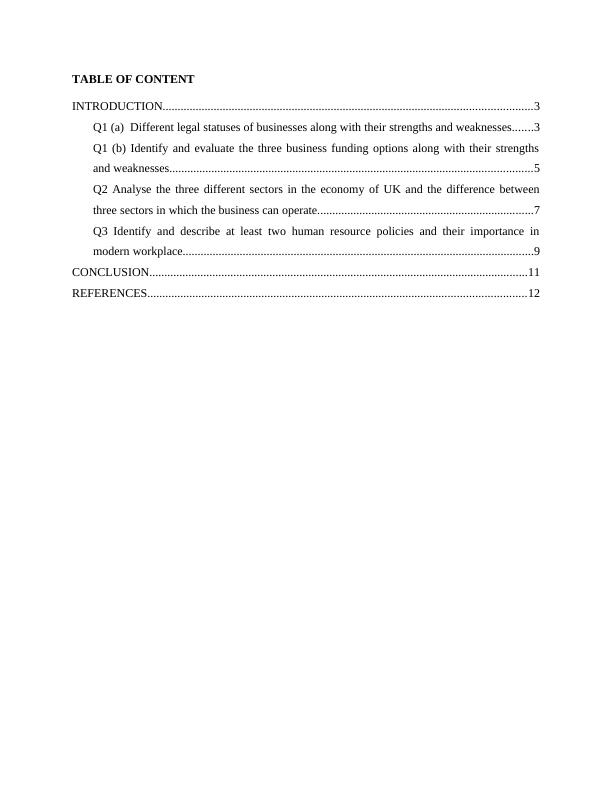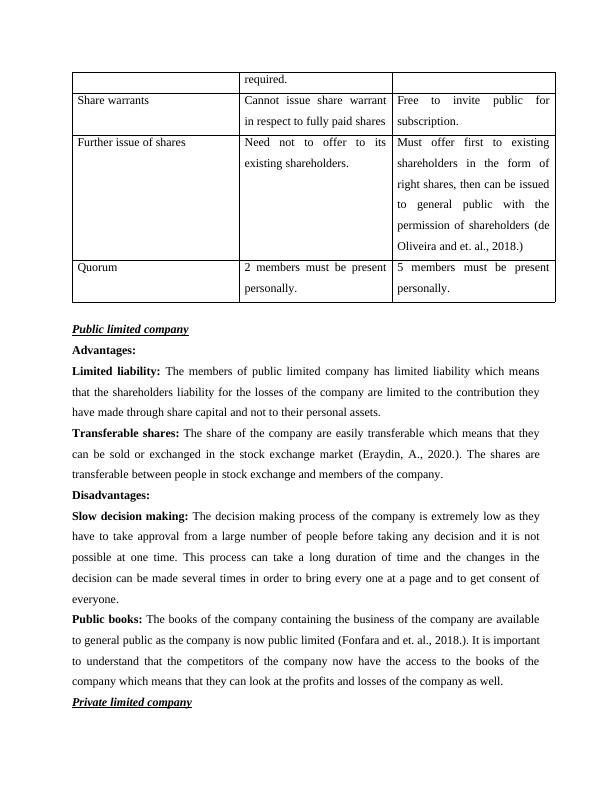Structure of Business
Added on 2022-11-28
13 Pages4142 Words250 Views
Structure of business.

TABLE OF CONTENT
INTRODUCTION...........................................................................................................................3
Q1 (a) Different legal statuses of businesses along with their strengths and weaknesses.......3
Q1 (b) Identify and evaluate the three business funding options along with their strengths
and weaknesses.........................................................................................................................5
Q2 Analyse the three different sectors in the economy of UK and the difference between
three sectors in which the business can operate........................................................................7
Q3 Identify and describe at least two human resource policies and their importance in
modern workplace.....................................................................................................................9
CONCLUSION..............................................................................................................................11
REFERENCES..............................................................................................................................12
INTRODUCTION...........................................................................................................................3
Q1 (a) Different legal statuses of businesses along with their strengths and weaknesses.......3
Q1 (b) Identify and evaluate the three business funding options along with their strengths
and weaknesses.........................................................................................................................5
Q2 Analyse the three different sectors in the economy of UK and the difference between
three sectors in which the business can operate........................................................................7
Q3 Identify and describe at least two human resource policies and their importance in
modern workplace.....................................................................................................................9
CONCLUSION..............................................................................................................................11
REFERENCES..............................................................................................................................12

INTRODUCTION
Start up is a business that is absolutely new in the market and has an intention to grow large and
will be able to become successful. The idea behind start up is always new and unique. Successful
start ups are those which have some unique qualities and are able to influence investors of the
market (Cavusgil and et. al., 2020.). Initially the start ups have high uncertainties and high risk
but eventually when they work in the right direction they will become successful. In context to
Hopin, it is a newly established start up in United Kingdom and the idea behind this start up is to
create in person experience of an event as closely as possible. The start up has raised around 419
million euros since January 2020.
Q1 (a) Different legal statuses of businesses along with their strengths and weaknesses.
Features Private limited company Public limited company
Minimum number of members There must be minimum 2
members.
Thee must be minimum 7
members.
Maximum number of members
allowed
There must not be more than
50 members.
The number of members can be
unlimited.
Least number of directors The company must have at
least 2 directors.
The company must have at
least 3 directors.
Restrictions on transfer ability
of shares
Their is a complete
restriction on transfer of
shares.
In this company their is no
restriction on transfer ability of
shares.
Issue of prospectus The company cannot issue a
prospectus (Corallo and et.
al., 2019.)
The company can issue
prospectus.
Consent of directors No consent is needed. Consent from registrar of the
company is needed
Commencement of business Immediately after
incorporation.
Certificate of commencement
is required.
Statutory meetings No restriction on statutory
meeting. Can be called
anytime as and when
Must have a statutory meeting
and must send statutory report
to registrar of company.
Start up is a business that is absolutely new in the market and has an intention to grow large and
will be able to become successful. The idea behind start up is always new and unique. Successful
start ups are those which have some unique qualities and are able to influence investors of the
market (Cavusgil and et. al., 2020.). Initially the start ups have high uncertainties and high risk
but eventually when they work in the right direction they will become successful. In context to
Hopin, it is a newly established start up in United Kingdom and the idea behind this start up is to
create in person experience of an event as closely as possible. The start up has raised around 419
million euros since January 2020.
Q1 (a) Different legal statuses of businesses along with their strengths and weaknesses.
Features Private limited company Public limited company
Minimum number of members There must be minimum 2
members.
Thee must be minimum 7
members.
Maximum number of members
allowed
There must not be more than
50 members.
The number of members can be
unlimited.
Least number of directors The company must have at
least 2 directors.
The company must have at
least 3 directors.
Restrictions on transfer ability
of shares
Their is a complete
restriction on transfer of
shares.
In this company their is no
restriction on transfer ability of
shares.
Issue of prospectus The company cannot issue a
prospectus (Corallo and et.
al., 2019.)
The company can issue
prospectus.
Consent of directors No consent is needed. Consent from registrar of the
company is needed
Commencement of business Immediately after
incorporation.
Certificate of commencement
is required.
Statutory meetings No restriction on statutory
meeting. Can be called
anytime as and when
Must have a statutory meeting
and must send statutory report
to registrar of company.

required.
Share warrants Cannot issue share warrant
in respect to fully paid shares
Free to invite public for
subscription.
Further issue of shares Need not to offer to its
existing shareholders.
Must offer first to existing
shareholders in the form of
right shares, then can be issued
to general public with the
permission of shareholders (de
Oliveira and et. al., 2018.)
Quorum 2 members must be present
personally.
5 members must be present
personally.
Public limited company
Advantages:
Limited liability: The members of public limited company has limited liability which means
that the shareholders liability for the losses of the company are limited to the contribution they
have made through share capital and not to their personal assets.
Transferable shares: The share of the company are easily transferable which means that they
can be sold or exchanged in the stock exchange market (Eraydin, A., 2020.). The shares are
transferable between people in stock exchange and members of the company.
Disadvantages:
Slow decision making: The decision making process of the company is extremely low as they
have to take approval from a large number of people before taking any decision and it is not
possible at one time. This process can take a long duration of time and the changes in the
decision can be made several times in order to bring every one at a page and to get consent of
everyone.
Public books: The books of the company containing the business of the company are available
to general public as the company is now public limited (Fonfara and et. al., 2018.). It is important
to understand that the competitors of the company now have the access to the books of the
company which means that they can look at the profits and losses of the company as well.
Private limited company
Share warrants Cannot issue share warrant
in respect to fully paid shares
Free to invite public for
subscription.
Further issue of shares Need not to offer to its
existing shareholders.
Must offer first to existing
shareholders in the form of
right shares, then can be issued
to general public with the
permission of shareholders (de
Oliveira and et. al., 2018.)
Quorum 2 members must be present
personally.
5 members must be present
personally.
Public limited company
Advantages:
Limited liability: The members of public limited company has limited liability which means
that the shareholders liability for the losses of the company are limited to the contribution they
have made through share capital and not to their personal assets.
Transferable shares: The share of the company are easily transferable which means that they
can be sold or exchanged in the stock exchange market (Eraydin, A., 2020.). The shares are
transferable between people in stock exchange and members of the company.
Disadvantages:
Slow decision making: The decision making process of the company is extremely low as they
have to take approval from a large number of people before taking any decision and it is not
possible at one time. This process can take a long duration of time and the changes in the
decision can be made several times in order to bring every one at a page and to get consent of
everyone.
Public books: The books of the company containing the business of the company are available
to general public as the company is now public limited (Fonfara and et. al., 2018.). It is important
to understand that the competitors of the company now have the access to the books of the
company which means that they can look at the profits and losses of the company as well.
Private limited company

End of preview
Want to access all the pages? Upload your documents or become a member.
Related Documents
Assignment on Managing Financial Resourcelg...
|12
|3404
|167
Positive and Negative Impacts of Macro Environmentlg...
|12
|3682
|181
The Structure of Business: Legal Statuses, Finance Sources, and HR Policieslg...
|14
|3835
|282
Foundations of Law - Assignmentlg...
|13
|3630
|23
BuS200 Business Management Assignmentlg...
|7
|1305
|227
Different Legal Statuses of Business and Sources of Financelg...
|13
|3935
|81
